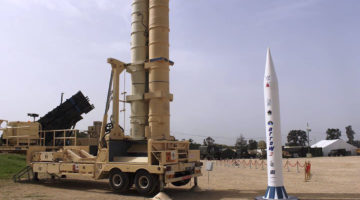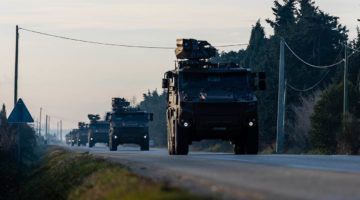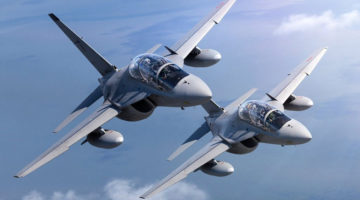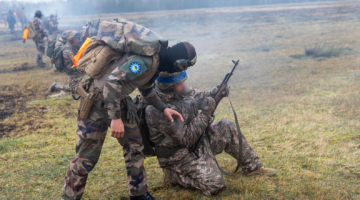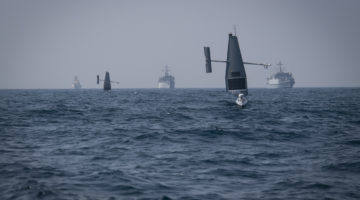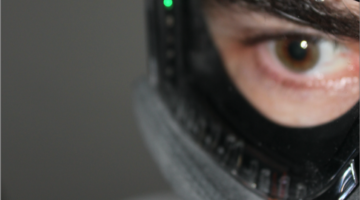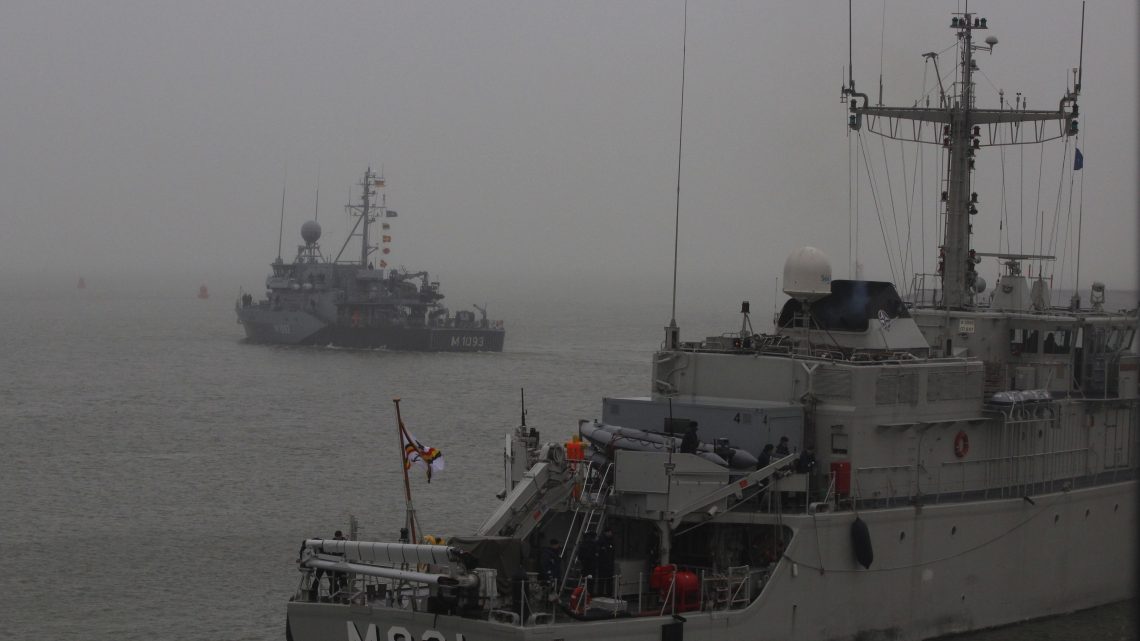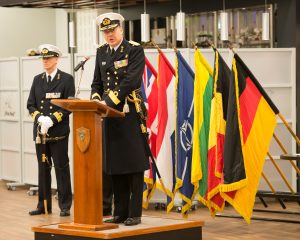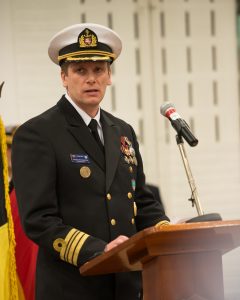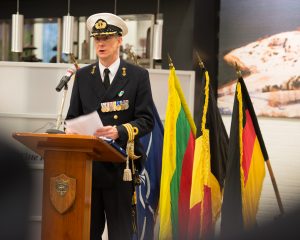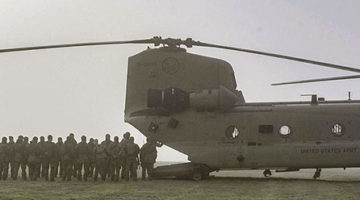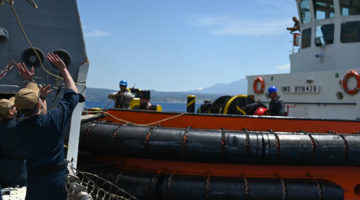MARCOM’s Support At Sea of NATO’s Very High Readiness Joint Task Force
Reportage by M. Delaporte – An interview with Commodore Arian Minderhoud, Royal Netherlands Navy, Deputy Chief of Staff, Operations, Maritime Allied Command
Commodore Minderhoud (DCOS Ops, MARCOM) attended the ceremony for the change of command of the Standing NATO Mine Counter Measures Group One (SNMCMG1), which took place in Den Helder in the Netherlands on January 22nd, 2015. In the interview below, he explains the mission of the maritime group within the context of the overall NATO response to the changing threat environment and economic development in its area of responsibility, i.e. the North and Baltic seas.
How does the SNMCMG1, which was reactivated about a year ago, fit with MARCOM and NATO’s strategy as a whole?
Under the authority of MARCOM, there are two Standing Maritime groups – composed at the moment with frigates and destroyers -, which operate in the Mediterranean, the Atlantic, the Baltic, and sometimes the Black sea area. Two other groups – MCM for Mine Counter Measures – are operating in the Baltic, North Sea and the Atlantic for Group One and the Mediterranean and the Black Sea for Group Two. This year, there is a combined operation for these two groups, but there is normally a division of labor between the two.
These four groups constitute the very core of NATO‘s maritime immediate reaction force and fit with the development of the Very High Readiness Joint Task Force (VJTF). As you may assume, if there is a developing crisis, these four standing groups, although different in their composition, would be the first ones in the operating area. Of course, if the crisis was to last, they would probably need to be reinforced with additional capabilities – such as C2, reconnaissance, Maritime Patrol Aircraft, submarines and so on -, in order to take command of a situation at sea in support of the Very high readiness joint task force. Joint, the VJTF will indeed be composed of Army and Air Force personnel with the maritime component being initially resourced from the NATO standing maritime groups.
If there is follow on action required (which should be assumed), there will be follow on forces resourced from NATO countries. There is not a clear definition of what these forces will look like, as they are not yet designed, but you must think along the lines of amphibious capabilities as well as more submarines, more air support and more expeditionary capabilities.
Immediate reaction forces bound to NATO maritime forces have a two to five day notice to move, but because these four groups are at sea or doing port visits, they are operational. The follow on forces have a five to seven day notice to move and can build up to thirty. This is how these forces fit in the concept and the current concept development of the VJTF. Again, I believe it is mostly important to underline that it is a JOINT task force. It is not only designed to do land-based operations alone, as they will have to be supported by air, air superiority, air control, as well as by the maritime dimension. Of course, there would be moments without the need for maritime support for the VJTF, but most of the time, you will need on the XXIth Century battlefield your logistics, your re-supply, your maritime awareness and dominance in the maritime area.
What is the impact of such a development on the way you are going to operate this year?
For the moment and as far as the four maritime groups are concerned, we are going along with the cycle of planning that we have, but we may expect that one of the biggest exercise will be used to trial, exercise and further develop the VJTF concept with the standing maritime groups being fully part of that exercise[1]. Many nations are going to participate, but there will be some core nations with brigades, such as Germany and the Netherlands which will constitute the very first Army brigade to support the VJTF.
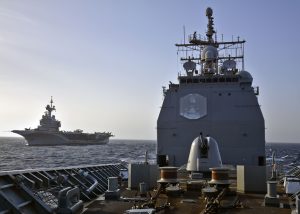
SNMG2 Exercises With French Aircraft Carrier in the Mediterranean in January 2015 (credit: NATO Photographer SNMG2}
Given the current events in Europe, how would you describe the main evolution of Allied Maritime Command?
I believe that NATO allies should be able to respond quicker and in a more effective way than in the past. We should be at a higher readiness state in order to be able to do so, therefore we need flexibility, jointness and the ability to operate and react in the high end of the operational spectrum. This implies more jointness, more international exercises and more exercises in the high end of warfare training. The way to achieve this is by increasing the tempo of international exercises and by working more with national Task Forces. NATO should be more systematically joining in bilateral and national exercises to make use of these opportunities and work with a large group of units, joint assets with lots of nations in the relevant areas. These areas are at the moment of course the Baltic – where the SNMCMG1 is operating -, the Black sea, the Mediterranean, and, for training opportunities, the Atlantic and the North Sea near Scotland. So, if there is an aircraft carrier strike group operating in the Med, of course NATO likes to join in to take that opportunity; same thing, if there is an American Marine Expeditionary Unit (MEU) operating, of course NATO likes to join in… We do try indeed to seize every single opportunity to jointly train and exercise together.
NATO forces already join in national Task Forces in order to enhance interoperability, as it is currently the case with France in the Mediterranean for SNMG2 and will be in the spring for SNMCMG1 for counter-mining manoeuvers of the shore of Cherbourg (French HOD Ops, for « Historic Ordnance Disposal Operations »). As Commander Dave Benham, MARCOM’s Chief Public Affairs Officer in Northwood, explains: « An example of NATO joining in national exercises is the way the SNMG2 currently operates with the French aircraft carrier group at sea. The follow on forces of the greater overall maritime capability of NATO are hence being reflected in the entirety of our forces, not just the ones under NATO command at any given time. »]
MARCOM has also been tasking counter piracy operations in the past years: how to you balance out all these priorities?
NATO has made the decision not to use Standing Maritime Groups on a rotational basis anymore for counter piracy operations. The reason why NATO is slowly withdrawing from counter-piracy is because we have not seen any successful attack since 2012, so, although the mandate has been extended till the end of 2016, the decision has been made to re-focus on NATO’s other priorities and its primary area of responsibility. NATO is therefore still committed to Operation Ocean Shield. With the deployment of ships, aircrafts, situation awareness capabilities, network and so on, however, NATO will not always have surface assets assigned to this operation.
As far as this specific group – the SNMCMG1 – is concerned, what kind of evolution do you foresee regarding its major missions, such as mine counter-measures, re-assurance and deterrence? Are reassurance missions more prominent today than legacy demining missions or is this a wrong assumption? In order to prepare an exercise, don’t you need to do real operation at the same time therefore constantly operating as you train? How does the group interact with amphibious operations?
I believe all missions are interlinked. Assurance is being faithful, so you need to have port visits close to the Baltic states, Poland and Germany, but in order to be effective you need to be able to commit your task as ordered. Mine counter-measures and operational readiness in the area are the primary tasks for the ships of this group. Reassurance is visual: it is all about being there and being ready as well. You need be ready before your task is ordered, so there is an interlinkage between operational readiness, assurance and collective defense.
As far as mine counter-measures go, HOD (Historic Ordnance Disposal) operations are indeed in the end NATO real operations: in the North sea, there are thousands of historic explosives from the WWII; in the Baltic the same: there is still a huge number of explosives on the seabed and one the task of this particular group is to make sure we search the seabed and take away all these explosives, so they do not penalize the shipping industry in these areas. Weather in the North Sea, the approach to Rotterdam or the Baltic, removing this historic ordnance is a task for a number of years to go. This mission has been done for a number of years in some of these areas, but it is becoming more important as the economic activity has been growing. We have to make sure all economic assets – weather an oil rig, a wind mill, or cables – are protected and that all activities, economic or naval operation, are conducted safely: the sea needs to be safe and that is one of our tasks as well, and part of the HOD Ops.
Regarding training, the task for an MCM unit is to make sure that the amphibious force can safely conduct operations. The MCM needs to make sure it is safe to send bigger and more expensive ships in that area, a task which can sometimes last several weeks. Making sure that a designated area is sufficiently safe for follow on operations is the primary task for MCM operations.
The reactivation of SNMCMG1 was triggered by the Russian-Ukraine crisis and the situation in Crimea[2] and we were able to do so as we had enough ships. There is a minimum requirement for this group of six MCM units, but, if there is a relevant and attractive program or exercise, more nations will join in with more ships. Under the precedent Lithuanian Commander, the group included up to nine ships in an exercise and under the upcoming Dutch Commander, there will be up to eight ships in some of the planned deployments. From a NATO point of view, if relevant programs and nations are able to contribute to the group, the more the better. The limit is simple: “we would like as many ships as we can”!
————————————————————————————————————————————————————————————-
The Challenge of Switching
Between NATO and National Task Forces
Between Multilateral Commands
Between Peacetime and Crisis Mode
By Commodore Minderhoud
« It is a national decision to participate in a crisis response operation. Before we start an operation under MARCOM authority, a decision is being made by each nation at the North Atlantic Committee level. If during a NATO mission, there is a national commitment for the ship to be under national command for a certain number of days, a nation can withdraw its unit from the NATO maritime group and bring the ship back under national command to perform the national task. It is a possibility, but it does not happen that often.
The process of transfer of Command which occurs twice a year is smooth, as the national authorities of the ships, NATO HQ in Mons and MARCOM command in Northwood all work very closely together. That process itself is rather flexible and reactive and just a few signals and telephone calls away…»
————————————————————————————————————————————————————————————-
Changing Command: The Views Of Both Commanders
Rewinding Six Months Ago …
« As commanding officer of SNMCMG1, my deployment started in a complex geopolitical situation. It was important to show that NATO countries responded in a very active way. The group consisted of eight units, an unprecedently high number for this group. Beside the prime mission of mine counter-measures, we did a lot of port visits. This was indeed very important part of our mission to go in Eastern Europe and in the Baltics, as these nations are facing a different environment than the Netherlands or the United Kingdom, in order to demonstrate that NATO is ready to assist and respond. The SNMCMG1 is one of the key players in this region in order to ensure stability and security. Being the first Lithuanian commander of this group, I was first of all very proud and delighted to take on this responsibility, as it also symbolizes the fact that NATO relies on its new members who show enough level of competence and professionalism. The deployment the mission was successful, as it fulfills all the tasks that were assigned. The challenges we faced ranged from bad weather in the Northern sea and initial interoperability issues to get to know each other among all the ships. We were happy with the high readiness level we were able to reach, which allowed the group to perform all the duties required. Some combined exercises like Joint warrior, which involved a variety of naval assets and amphibious forces, were especially good to train interoperability and enhance understanding between different groups. »
… Forwarding Six Months Ahead
« I feel very proud to be able to have this command for a whole year with two ships from Germany, one from the United Kingdom and one from Belgium, which soon will be augmented by Dutch and Polish ships to keep the readiness of the group as high as possible. We have a staff of nine working constantly and the composition of the group will change over the year, as I am started with four ships, but other groups will come and go and more ships will get assigned to the group during specific exercises.We will participate the first half year alone in five different big exercises and we shall do historic ordnance clearing in Germany, near Estonia, near the Dutch and Belgium coast, as well as in France.
We therefore have quite an extensive program for the first six months of deployment already…»
Footnotes :
[1] NDLR: NATO’s major joint exercise in 2015 is Trident Juncture. For details, see our two interviews about NATO training with French Lieutenant-Colonel Thozet and US Navy Lieutenant Commander Chris Hahn, published in: Opérationnels SLDS # 19, Summer 2014, pages 13 to 16.
[2] « This group has been in operation for more than forty years and went briefly into a period of abeyance last February, before being reactivated by SACEUR », explains Commander Benham.

